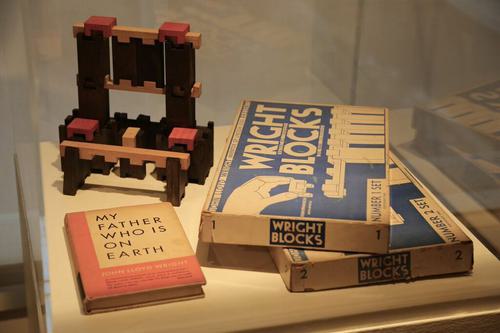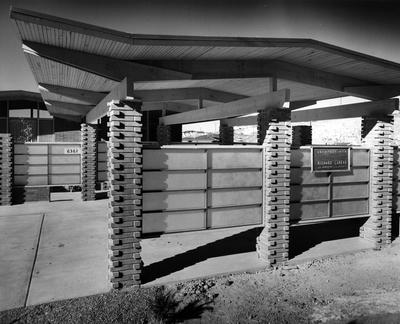Design
Lincoln Logs: Toying with the Frontier Myth John Lloyd Wright, Inventor of the Construction Toy

Architect John Lloyd Wright designed a number of toys from his Del Mar studio from his early Wright Blocks to the widely successful Lincoln Logs.
By Erin K. Cho

Interesting playthings typifying "the spirit of America"' was the slogan John Lloyd Wright used in 1918 to market and sell his new toy, Lincoln Logs. To this date few have written about this famous toy and its creator. Perhaps this is because in 1939 a fire destroyed many of the documents from Wright's early career. An architect by profession, Wright has remained somewhat anonymous, possibly because his accomplishments seem slight compared to the works of his father, Frank Lloyd Wright, one of America's foremost architects of the twentieth century. Yet this paucity of research is most likely a result of the current embryonic stage of material cultural history.
According to the historian John Brewer, the attention devoted to 'high' culture has not been given to such things as costume, the tools of a trade, household utensils and furniture, and playthings. Often overlooked, toys invariably reveal assumptions made by adults about the culture in which they live or the values they think desirable. In revisiting and analysing the period between 1900-20, the years of Wright's youth, it is possible to capture the influences which led him to invent this historic toy in 1918.
Before being fired by his father, in 1918, John was designing his line of wooden toys for Chicago's Marshall Field & Co. including the patented Lincoln Logs (working as John Lloyd Wright, Inc.). According to biographers, Sally Kitt Chappell and Ann Van Zanten, “In the early 1950s, [John Lloyd Wright]… renewed his activities as a toy designer, now concentrating on construction block sets. In late 1949 he patented—and in 1950 began to sell—a new version of his Wright Blocks, an interlocking block set which he had first patented in 1933. These were rectilinear, cross-grooved wooden blocks packaged in "No. 1" and "No. 2" sets of 36 and 70 pieces respectively, which differed slightly in the types of pieces they included and in the materials used. Some sets were in a variety of natural woods while others were colored with watercolor stains. The Wright Blocks were not only more abstract and modern than Lincoln Logs, but they were also more versatile and could be assembled into lighter, more open structures. Nevertheless, they failed to catch the public's fancy to the same extent as their log cabin predecessors and were not produced in any great quantity.” - Keith York
Similarly, Froebel's methods influenced John's system of design of both his buildings and his toys. His experimenting with the design of toy construction blocks reflected an education which emphasized rhythmic pattern, prefabrication, and construction from interchangeable elements. Lincoln Logs required special care to repack and came in a much greater variety of sizes than today's version. This compelled children to work out what was to be built through trial and error, forcing them to observe, take to pieces and to reassemble.
Born on December 12th, 1892, in Oak Park, Illinois, John Lloyd Wright was the second son in a family that would come to number four boys and two girls. The Wright children's activities were centered on the playroom that their father added to their house in 1895. The long, high vaulted room was full of building blocks of all shapes and sizes. A firm believer in Friedrich Froebel's 'Kindergarten' methods, Frank Lloyd Wright and his wife, Catherine, educated their children according to Froebel's theories. This training, which was directed towards the development of analytical thinking, assumed that for the child who observed, took to pieces, and reassembled things, the desire to create shape and form was a natural instinct. This was the basis of Frank's own childhood education..Emphasizing learning from nature, it reinforced knowledge Frank had gleaned from his early experiences on his uncle's farm in Wisconsin and introduced him to the formative geometrics that became the basis for his architecture.
Lincoln Logs are significantly distinct from the other abstract construction block toys Wright created later in his toymaking career. This difference stems from America's mentality preceding and surrounding Wright's creation of the toy. John Lloyd Wright grew up in a period of reform, now referred to as the 'Progressive Era'. There was concern among civic-minded members of the middle classes about what the urbanisation of life would do to national virility and traditional American values. These fears were embraced by President Theodore Roosevelt who, along with historian, Frederick Jackson Turner, questioned whether American ideals and institutions could survive the closing of the frontier.
While progressives were busily improving the political and economic environment through institutional and legislative means, they were also advocating the ethic of simple living. Crying out for discriminating consumption, social service, aesthetic simplicity, and a renewed contact with nature, activists believed that Jeffersonian simplicity was of profound relevance to modern urban industrial life. Consequently, as the wild became increasingly remote to urban dwellers in the twentieth-century, they tried to surround themselves with its symbols. Companies such as L.L. Bean which marketed sporting, outdoor, and hunting gear rose to success while popular magazines of the day promoted ideas such as 'if you cannot build a "cabin in the woods", it may be the next best thing to tuck one away somewhere in your home. It will at least help you imagine that you have escaped from the rigors of everyday life'.
America's nature-lovers lost no time in adapting this ideology to their children's minds. Fictionalized accounts of the adventures of the 'Bobbsey Twins' and 'Camp Fire Girls' soon seeped into children's literature, reviving America's heritage of outdoor adventure. John and his siblings were representative of the audience these books were geared towards: American children who had the time and money to make a virtue of outdoor life. John describes the books they had access to in their Oak Park home: Long, thick, big, little books. Covers without books, books without covers; colored, patterned, and textured papers in large folios, all piled up and pushed on wide ledges on either side of a long window. John would have been familiar with these heroes and heroines who spent their free time from school in field or forest, displaying the type of childhood middle-class parents saw as healthy and admirable.
During high school, John made a conscious decision to spend his summer vacations at his great-uncle's farm in Wisconsin as his father had. Perhaps John's regard for nature had increased as the camping movement became a major activity among middle-class youth. The message that camps would foster healthy bodies, simplicity, and a love for and knowledge of nature was appealing to early twentieth-century Americans who were worried about the degenerative effects of urban life. Organisations such as the ‘Woodcraft Indians', ‘The Boy Scouts of America', and 'Camp Fire Girls' were founded during the early 1900s upon the premise of teaching woodcraft, natural history, Indian-lore, and, above all, democratic values.
John found himself further influenced by these trends because his father was a fervent believer in the Progressive notions about outdoor life and simple living. An articulate champion for the social role of architecture, Frank Lloyd Wright expressed his sentiments in his works. Disgusted with the ‘General Grant Gothic' style that dominated neighbourhoods in the late Victorian America, Wright embraced as his guiding design concepts a union of simplicity with an organic aesthetic and settled in the Chicago area to work with Louis Sullivan, an architect who once announced 'the intellectual trend of the hour is toward simplification'.
When Edward Bok of Ladies' Home Journal led a highly published campaign in the early twentieth-century for inexpensive, simplified domestic architecture, Frank Lloyd Wright submitted designs of his 'prairie house'. The main rooms of these 'prairie houses', which Wright introduced to the magazine's readers as a 'simple mode of living in keeping with a high ideal of family life together', flowed together in uninterrupted space that, in effect, continued outside. Wright enhanced these efforts to harmonize his buildings with the natural environment not only by implementing earthy colours and rich textures, but also by using wood. Declaring that 'wood is the most humanly intimate of all materials', Wright often stated that it was the Japanese who best understood the uses of wood: In Japanese architecture may be seen what a sensitive material alone for its own sake can do for human sensibilities, as beauty, for the human spirit. Whether pole, beam, plank, board, slat, or rod, the Japanese architect got the forms and treatments of his architecture out of tree nature, wood wise, and heightened the natural beauty of the material by cunning peculiar to himself.
In 1915, Japan's imperial household invited Wright to build the Imperial Hotel in Tokyo. Frank took his son, John, with him when he went to oversee the project two years later. In the hotel's construction, Frank implemented a revolutionary technique referred to as 'floating cantilever construction', where projecting beams were joined or locked into beams extending from opposite piers. According to John, it was this construction technique which inspired him to create Lincoln Logs, miniature hardwood logs notched on the sides to fit into each other, in Japan one year letter. The esteem his father had for wood as a building material no doubt influenced John's decision to choose it as a material for his blocks.
Many have claimed, however, that John Loyd Wright's Lincoln Logs were simply a modified version of Joel Ellis' 'Log Cabin Playhouse', invented in 1866. They support this contention with the speculation that John probably played with such a toy as a child. Whether or not this is true, there is evidence that other forces may have inspired him to create this log cabin toy and break conventional marketing techniques (rather than including a photograph of children playing with logs, John packaged his toy in colourful boxes with a simple drawing of a log cabin on the front). Even though the log cabin was a Swedish import and had not been adopted by English settlers until well into the eighteenth century, between 1840 and 1918, writers and illustrators had mythologised log cabin living. Dramatised in the presidential campaigns of 1840 and 1860, the log cabin came to be identified with democracy and the frontier spirit as Americans began to marvel at their own progress and to make a virtue of their early struggles with the wilderness. These sentiments were confirmed with the publication of Mary Newton Standard's widely read Colonial Virginia in 1907, which erroneously concluded that Virginian settlements consisted of log cabins. It was during this period when the log cabin 'myth' was at its full height, and when the virtues it carried appeared to be under threat that, Wright developed his toy -- a toy which reinforced the myth, and reminded American children of their proud heritage.
Finally, we must ask why John Lloyd Wright named his toy after Abraham Lincoln? At the turn of the century, Lincoln had already become a symbol of unity, hope, and inspiration for all citizens. There were a great number of celebrations and commemorations of Lincoln while John was growing up: in 1909, the nation celebrated his 100th birthday; in 1911, the log cabin where Lincoln was born was dedicated by President Taft; and in 1916, President Wilson delivered the acceptance speech when this log cabin was presented to the United States by the Lincoln Farm Association. Moreover, from 1901 plans for a Lincoln Memorial were being debated in Congress. During this period when Americans felt the ideals and institutions from its frontier past were being threatened by increased industrialisation and urbanisation, the values Lincoln represented were extremely potent. Lincoln reminded Americans that their country was a unique place where 'every door is open ... for the ruler to emerge when he will and claim his leadership in the free life'. Lincoln's log cabin birthplace emerged as a powerful symbol demonstrating that every individual, no matter how humble his origins, could achieve greatness. John Lloyd Wright, like any American, probably encountered a barrage of such images deifying Lincoln. His toy's simple title captures the sentiments of this period, reaffirming a sense of patriotism to Progressive America as it found itself entering the Great War. Contributing to the spirit of the times, Wright included two portraits of Lincoln on the covers of his sets of Lincoln Logs.
Never able to give himself over completely to toys, John Lloyd Wright resumed his career in architecture shortly after inventing Lincoln Logs. Because he believed in his father's guiding principles of design, emphasising an intimate relationship between interior and exterior space partly through the use of natural materials, John continued to struggle between his father's dominating personality and style and his own creative development. Despite his conflict, he produced original works such as 'The Holden House', or 'House of Wood', and 'Shangri-La', or 'House of Seven Levels', which reflected his affection and remarkable skill with wood. Although his interest turned away from toys, other toymakers tried to capitalise on Wright's success. Lincoln Bricks and Lincoln Stones both made brief appearances on toyshop shelves. When Halsam's American Logs were produced in 1934, toymakers expected them to be a success, for the logs' notched indentations looked far more realistic than Wright's. But although Halsam's Logs were marketed for years, they were always in the shadow of Lincoln Logs; children even referred to these so-called 'improved' logs by their predecessor's name. Today, up to a million American consumers buy a set of Lincoln Logs for their children every year, suggesting that the values and ideals this toy represents are still important in an increasingly technological world.
Perhaps our needs are not so distant from Progressive Americans. Though the issue of urbanisation is no longer new and the spectre of world war does not haunt us, the growing sentiment that America is in decline perhaps sparks a desire among American parents to provide their children with toys that evoke their country's unique heritage. Finally, although conditions no longer exist wherein one in every seven Americans is a slave, because one in every seven Americans lives in poverty, the name Lincoln represents values and ideals as important to us now as they did a century ago. Thus, although as an architect John Lloyd Wright found himself in the shadow of his father, as a toymaker he cast a unique and lasting light on an institution called childhood; here, Frank Lloyd Wright could never compete.
COPYRIGHT April 1993 History Today Ltd., COPYRIGHT 2004 Gale Group


